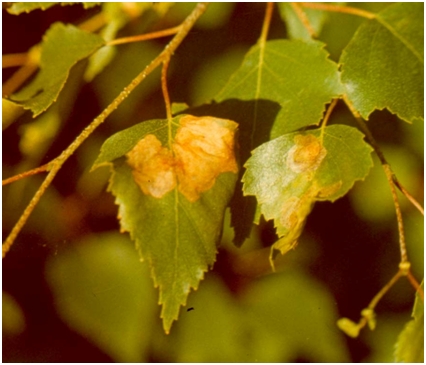Birch leafminer is one of the most common leaf problems that distress homeowners. This insect was not a major issue for many years but has definitely shown up in larger numbers recently. Birch leafminers are the caterpillar-like larvae of at least 3 or 4 species of tiny sawflies that mine birch leaves. Sawflies are named for the saw-like ovipositor (egg-layer) at the ends of the female’s abdomens. The female sawfly cuts a slit in a birch leaf with her ovipositor and lays an egg inside the leaf. The Birch Leaf Miner does this in late May and a second generation follows two weeks later. Other similar species perform their egg laying later in the spring or summer. Sawflies over winter as pupae in the soil beneath a birch tree. In spring the emerging adults mate and the females fly to birch leaves to lay their eggs.

Key Points
- Keep your birch well-watered, as birch need more water than most trees. Birch health is mainly a function of how much water they receive.
- Brown patches on birch leaves is the evidence of feeding of the caterpillar-like larvae inside the birch leaf.
- Not all chemical sprays are effective, since the larvae are protected inside the leaf.
- A new system of injecting pesticide directly into the stem of the tree has been developed and has shown some promise in controlling this insect.
Tree Damage
Brown patches on birch leaves is the evidence of feeding of the caterpillar-like larvae inside the birch leaf. If an affected leaf is held to the light, the leaf appears hollow and black frass (larval excrement) can be seen. The larva may also still be feeding inside the leaf. Repeated infestation for several years may weaken the affected tree.
Control Measures
- Chemical sprays are not always effective, since the larvae are protected inside the leaf. Cygon, a systemic pesticide that was once used as a soil drench is no longer available and should not be used because of its toxicity to other organisms and humans.
- A new system of injecting a biological pesticide directly into the stem of the tree has been developed and has shown some promise in controlling this insect.
- Natural populations of predaceous non-stinging wasps will eventually have these sawflies under control. Infestations will be reduced naturally and damage will be limited, and may not recur every year.
- Keep your birch well-watered, as birch need more water than most trees. Birch health is mainly a function of how much water they receive. and how cool the roots are kept

